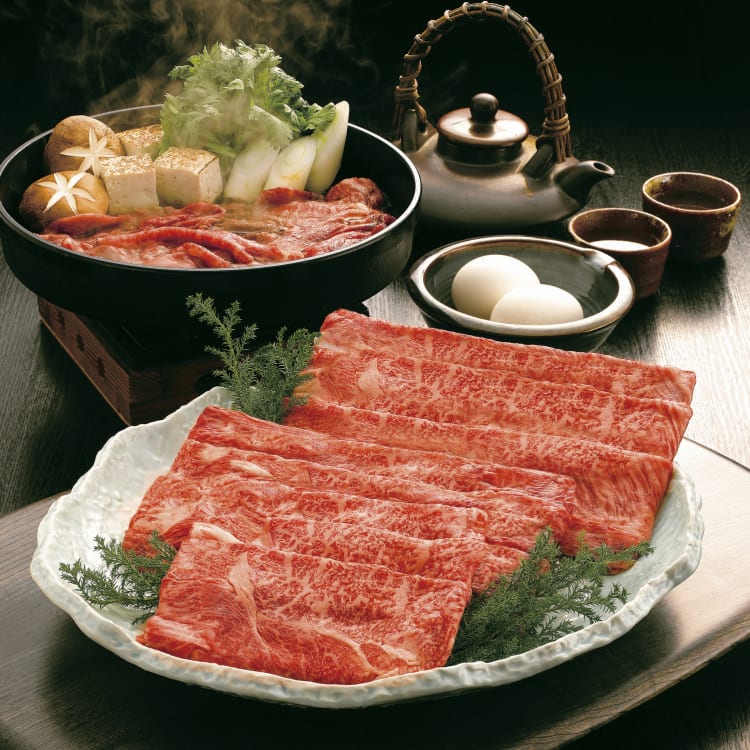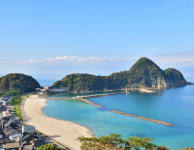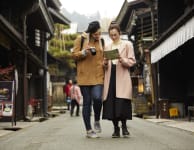

STORY Tasting Traditions: The Origins of Japanese Cuisine [Sponsored]
(This image is for illustration purposes only).
Hyogo is home to two of Japan's most iconic culinary exports, born from harmony with nature and centuries of tradition
Hyogo's prefectural capital, Kobe, was one of the first ports in the country to open to the West, acting as a global gateway into Japan. It remains a gateway, to the Kansai area at large, and to two of the world's most famous parts of Japan's cuisine culture: Kobe Beef, and Japanese sake. Hyogo isn't just the birthplace of Japan's premium wagyu beef brand, but also of Yamada-Nishiki, a variety of rice known as “the king of sake rice”. Hyogo is Japan's largest producer of Yamada-Nishiki rice, which is prized by sake brewers all over the country to create high-quality sake. Hyogo is also home to the UNESCO-recognized Himeji Castle, as well as idyllic hot spring resort areas. Hyogo is easily accessible from popular destinations like Kyoto and Osaka, and a cultural and culinary journey through the prefecture is a worthy addition to any Kansai travel itinerary.
Birthplace of Japanese beef

Only the best quality Tajima Beef can be called Kobe Beef.
Wagyu, Japan's premium beef, is renowned the world over for its quality. Kobe Beef is the most famous of Japan's regional wagyu brands, with well-marbled meat both tender and flavorful. Kobe Beef comes from the highest quality, purebred Tajima cattle, Hyogo's own breed. Only the highest quality Tajima Beef can be called Kobe Beef, making it exceedingly rare.

Purebred cattle graze in the lush pastures of Tajima.
The Tajima region, the birthplace of Tajima cattle, is ideal for raising cattle, with gentle pastures and ample fresh water. Visit the Tajima Pasture Park to learn more about the care and consideration that goes into breeding and rearing Tajima cattle.
At the farm in Tajima Pasture Park, you can enjoy the scenic beauty of the region and interact with animals. As well as Tajima cattle, they breed sheep, goats, and rabbits and other animals which graze on the farm. The Tajima Cattle Museum in the park features exhibits about the extensive history and processes of Tajima cattle rearing. There is also an onsite restaurant that serves local beef and other dishes, tennis courts, a slope for skiing and snowboarding in winter, and accommodations for an overnight stay.
Hyogo's sake legacy

Yamada-Nishiki rice from Hyogo is considered the best in Japan for making sake.
Sake is Japan's national drink and is made primarily from three simple ingredients: rice, water, and koji rice mold. Hyogo is a major producer of rice for sake, and an important area for sake production. In 1928 Hyogo established a prefectural Sake Rice Test Site to conduct experimental research on strains of “sake rice”. They struck gold in 1936 with the successful cultivation of Yamada-Nishiki.
Yamada-Nishiki is ideal for sake brewing. It is large-grained, with a big, starchy core. During sake production the outside layer of the rice grain is milled away, leaving the pure starch at the center. The amount of milling determines the type of sake produced. For example, more than fifty percent of the rice grain is milled away when making premium Junmai Daiginjo sake.
Yamada-Nishiki's behavior during brewing is also relatively easy to control, which is an important factor for planning the flavor profiles of sake. For these reasons it has become the most popular sake rice strain to use in brewing across the country. Hyogo Prefecture grows about sixty percent (as of 2020) of the Yamada-Nishiki used in domestic sake brewing.
Yamada-Nishiki, the “king of sake rice”, is one of the most challenging rice varieties to cultivate. It requires the passion and skill of the farmers who grow it, as well as the soil, sunlight and local climate of Hyogo. To learn more, visit the Yamada-Nishiki no Sato . This aptly named facility features a museum dedicated to the development and history of Yamada-Nishiki, a tasting room where you can sample sake from Hyogo Prefecture for a fee, and a restaurant serving dishes made from local ingredients. For a little rest and relaxation, visit the onsite hot spring, which has outdoor baths, footbaths, and baths that can be reserved for private use.
Nada Gogo: Hyogo's sake heartland

Sample Hyogo's world-class sake in the five villages of Nada. © KOBE TOURISM BUREAU
The people of Hyogo have spent centuries brewing Japan's national beverage, and no area exemplifies their sake legacy better than the Nada Gogo, or the five villages of Nada: Nishi, Mikage, Uozaki, Nishinomiya, and Imazu. Located in a few-kilometer-long stretch of town just a short train ride from central Kobe, the Nada Gogo has been brewing sake since the 1300s, and is the largest sake-producing region in Japan. A stroll through this historic area offers visitors the chance to visit some of the prefecture's most popular breweries, take tours to learn about the production process, and—most importantly—sample some of their world-class sake.
Hakutsuru Sake Brewery Museum is in the area that was once Mikage. It has free admission to its former brewhouse, which has been converted into a museum. Exhibitions feature vivid recreations of each step of the sake production process, including traditional tools used for brewing. In the sake-tasting room visitors can sample products not available anywhere else. Similarly, the shop and restaurant at the nearby Kobe Shu-Shin-Kan brewery offer the opportunity to taste and buy a range of sake and original products, and to enjoy traditional Japanese cuisine. The facility was renovated in 2017 and features brochures in 16 languages about the history of sake brewing.
Exploring Hyogo's castles


Himeji Castle is one of Japan's best-preserved castles. Takeda Castle Ruins appear to float above the clouds. © Toshihisa Yoshida
What better way to work up an appetite than by exploring two places that embody the prefecture's samurai heritage? Himeji Castle is one of Japan's best-preserved castles, and its white, elegant form stands in stark contrast to the mist-shrouded stone Takeda Castle Ruins, which is sometimes called the "castle floating in the sky."
Less than an hour from Kobe by train (or around 15 minutes by shinkansen), Himeji Castle is one of Japan's 12 remaining original castles. It was built in 1609 and has stood strong through the centuries thanks to conservation and restoration work (most recently completed in 2015). Himeji Castle is also known as Shirasagi Castle (literally “White Heron” Castle), in part because of its sweeping white roofs and walls. It is widely regarded for its beauty; the castle is both a National Treasure and a UNESCO World Heritage Site. Its expansive grounds look especially stunning in spring, when covered in vibrant cherry blossoms. The Himeji area is known for its conger eel, and there are many restaurants near Himeji Station where visitors can dine on this regional delicacy.
The Takeda Castle Ruins are about an hour from Himeji in Asago, in the mountains of northern Hyogo. According to one theory, Takeda Castle was originally built around 1443 but was abandoned shortly after the Battle of Sekigahara in 1600, a decisive conflict that gave rise to the Tokugawa shogunate which ruled Japan during the Edo period (1603–1867). Over the centuries the mountaintop buildings crumbled, but the castle's stonework remains, and are now a popular tourist site sometimes likened to Machu Picchu. When weather conditions are right, a “sea of clouds” shrouds the mountains in mist, making the ruins appear as if they are floating in the sky. Autumn sees these conditions most commonly, making it the most popular time of year to visit.
Soak in the scenery

Stroll the beautiful streets of Kinosaki onsen at night.
No journey through Hyogo would be complete without paying a visit to one of its historic hot spring villages for a little rest and relaxation.
Kinosaki Onsen has a history spanning over 1,300 years, and is one of Japan's best-known retreats. Located near the coast in northern Hyogo, the town is surrounded by inland mountains. Its retro townscape is comprised of many ryokan, traditional inns where guests can enjoy an overnight stay, dine on meticulously prepared cuisine paired with local sake, and soak away their stress in a luxurious natural hot spring. Overnight guests also get access to Kinosaki's seven public bathhouses, which also allow visitors with tattoos. Many guests explore the town in a yukata (light cotton kimono), strolling through the willow-lined streets on their way from one bath to the next.

The hot spring waters at Yumura Onsen are hot enough to cook vegetables.
Or experience the charms of slow travel with a leisurely stay at the equally historic Yumura Onsen . This atmospheric town has been in operation for over 1,200 years and is home to about 60 springs. The temperature of the water flowing from the springs is some of the hottest in the country (about 98°C), and residents of the area have developed a custom of using the water to boil vegetables and eggs. Yumura is in a secluded mountain valley, offering a tranquil getaway.
A Taste of Kobe

Kobe is famous for delicious food, from Kobe Beef to Chinese delicacies. © KOBE TOURISM BUREAU
As the prefectural capital, Kobe is an ideal base for exploring the rest of the Hyogo. The compact port city is also full of vibrant flavors, with many types of cuisine to enjoy. Nankinmachi is Kobe's Chinatown, full of food stalls selling street food favorites like dumplings and steamed buns. There are over a hundred restaurants and shops, serving up favorites like dim sum, ramen, and steak. Sannomiya, on the other hand, is a sightseeing hotspot. The north side is full of cafes, bars, and restaurants (many of which serve Kobe Beef), and the south side features a 600-meter-long covered shopping arcade, the perfect place to pick up a souvenir.
Getting to and around Hyogo

Kobe is easy to access from Osaka and Kyoto via the Tokaido-Sanyo Shinkansen. (Image courtesy of JR Tokai)
Kobe is easy to access from major cities in the Kansai area, including Kyoto and Osaka. It is about 30 minutes to Shin-Kobe from Kyoto via the Tokaido-Sanyo Shinkansen, and about 20 minutes from Osaka via the Tokaido-Sanyo Line Special Rapid.
Many of Hyogo's destinations, such as Himeji Castle and the Nada Gogo, can be easily reached by train from central Kobe. More remote destinations such as Kinosaki Onsen Yumura Onsen can take between 3-4 hours to reach by train or bus. Rental car is another convenient way to explore the scenic, rural areas in northern Hyogo.
Business hours
Due to measures to prevent the spread of coronavirus, business hours and conditions may be subject to change; please check with the venues before visiting.




































































